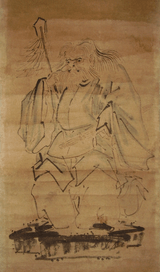Sarutahiko Okami
<th class="" style="padding:0.1em;;padding:0.5em 0 0.1em 0; font-size:120%; color: white; line-height:1.0em; style="text-align:center; background: #EEEEEE;;">
Practices and beliefs<th class="" style="padding:0.1em;;padding:0.5em 0 0.1em 0; font-size:120%; color: white; line-height:1.0em; style="text-align:center; background: #EEEEEE;;">
Shinto shrines<th class="" style="padding:0.1em;;padding:0.5em 0 0.1em 0; font-size:120%; color: white; line-height:1.0em; style="text-align:center; background: #EEEEEE;;">
Notable Kami<th class="" style="padding:0.1em;;padding:0.5em 0 0.1em 0; font-size:120%; color: white; line-height:1.0em; style="text-align:center; background: #EEEEEE;;">
Important literature<th class="" style="padding:0.1em;;padding:0.5em 0 0.1em 0; font-size:120%; color: white; line-height:1.0em; style="text-align:center; background: #EEEEEE;;">
See also| Part of a series on |
| Shinto |
|---|
|
|
|
Sarutahiko Ōkami (猿田毘古大神, 猿田彦大神), is the leader of the earthly kami, deity of the Japanese religion of Shinto. Sarutahiko Ōkami is seen as a symbol of strength and guidance, which is why he is the patron of martial arts such as aikido.[1]
Sarutahiko Ōkami is a powerful guardian kami who is enshrined at Tsubaki Grand Shrine in Mie Prefecture, first among the 2,000 shrines of Sarutahiko Ōkami and Sarutahiko Jinja in Ise and Ōasahiko Shrine in Tokushima Prefecture. In the Kojiki, he is the one who greets Ninigi-no-Mikoto, the grandson of Amaterasu, the Sun goddess, when he descends from Takamagahara.[2] He is depicted as a towering man with a large beard, jeweled spear, ruddy face, and long nose. At first he is unwilling to yield his realm until persuaded by Ame-no-Uzume-no-Mikoto, the kami of dance and the arts, whom he later marries.[3]

His name consists of an etymologically obscure element, Saruta, which is traditionally transcribed with kanji (猿田) that suggest the meaning "monkey-field" as a sort of double entendre, followed by the Classical Japanese noun hiko "a male child of noble blood, a prince."[4] Thus, Sarutahiko Ōkami's embellished name could be roughly translated into English as "Great God, Prince Saruta." Many variant pronunciations of his name exist, including Sarudabiko and Sadahiko. Although it is usually not written, the Japanese genitive case marker, -no, is often suffixed to his name in speech when it is followed immediately by one of his honorific titles, such as Ōkami or Mikoto.[citation needed]
Sarutahiko has the distinction of being one of only six kami to be honored with the title Ōkami (大神) or "Great Kami"; the other five are Izanagi, Izanami (in her Persephone-like role as Queen of the Underworld), Michikaeshi, Sashikuni, and Amaterasu. The special honor paid to Sarutahiko is particularly notable for the fact that he is the singular kunitsukami, or earthly kami, to be given the title; the other five are all amatsukami, i.e., heavenly kami.[citation needed]
References in music
The name of this deity appears incorrectly spelled as "Sarundasico" in Puccini's opera Madama Butterfly.[5]
See also
References
- ↑ Gleason, William (1995). The Spiritual Foundations of Aikido. Destiny Books. p. 18. ISBN 0-89281-508-6.
- ↑ "English". 尾張猿田彦神社. Retrieved 14 August 2012.
- ↑ "Shrine History". Tsubaki Grand Shrine America. Retrieved 13 August 2012.
- ↑ Ashkenazi, Michael (2003). Handbook of Japanese Mythology. ABC-CLIO. p. 70. ISBN 1-57607-467-6.
- ↑ "2004 Regular Opera Performance "Madama Butterfly / revised edition"". NPO Opera del Popolo. Retrieved 13 August 2012.